Reduce your Data Debt
Chart the present, then design the future shape of your data
Everyone in IT knows about technical debt. Technical debt (also known as tech debt, code debt, or design debt) is a metaphor that describes possible consequences of development teams prioritizing the delivery of a functionality or project, which later needs to be refactored or redone.
Technical debt can be intentional and should be reserved for cases when developers consciously adopt a design strategy that is not sustainable in the long run, but yields a short term benefit, such as shipping a release. Unintentional tech debt may be the consequence of a "quick-and-dirty" or a "move fast and break things" approach.
A second axis is described by Martin Fowler in his 2009 article on the technical debt quadrant, making a pertinent distinction between prudent and reckless technical debt.
What is data debt
Data debt is a type of technical debt that refers to the accumulated cost of poor data management practices, such as incomplete, inaccurate, or unstandardized data, which hampers efficiency and decision-making over time.
More than a nuisance, data debt results in unreliable data and manual data management. Data debt undermines a organization's ability to be data-driven by reducing data quality, slowing decision-making, increasing costs, and eroding trust in insights.
Although data debt and tech debt are closely connected, there is a key distinction between them: you can declare bankruptcy on tech debt and start over, but doing the same with data debt is rarely an option.
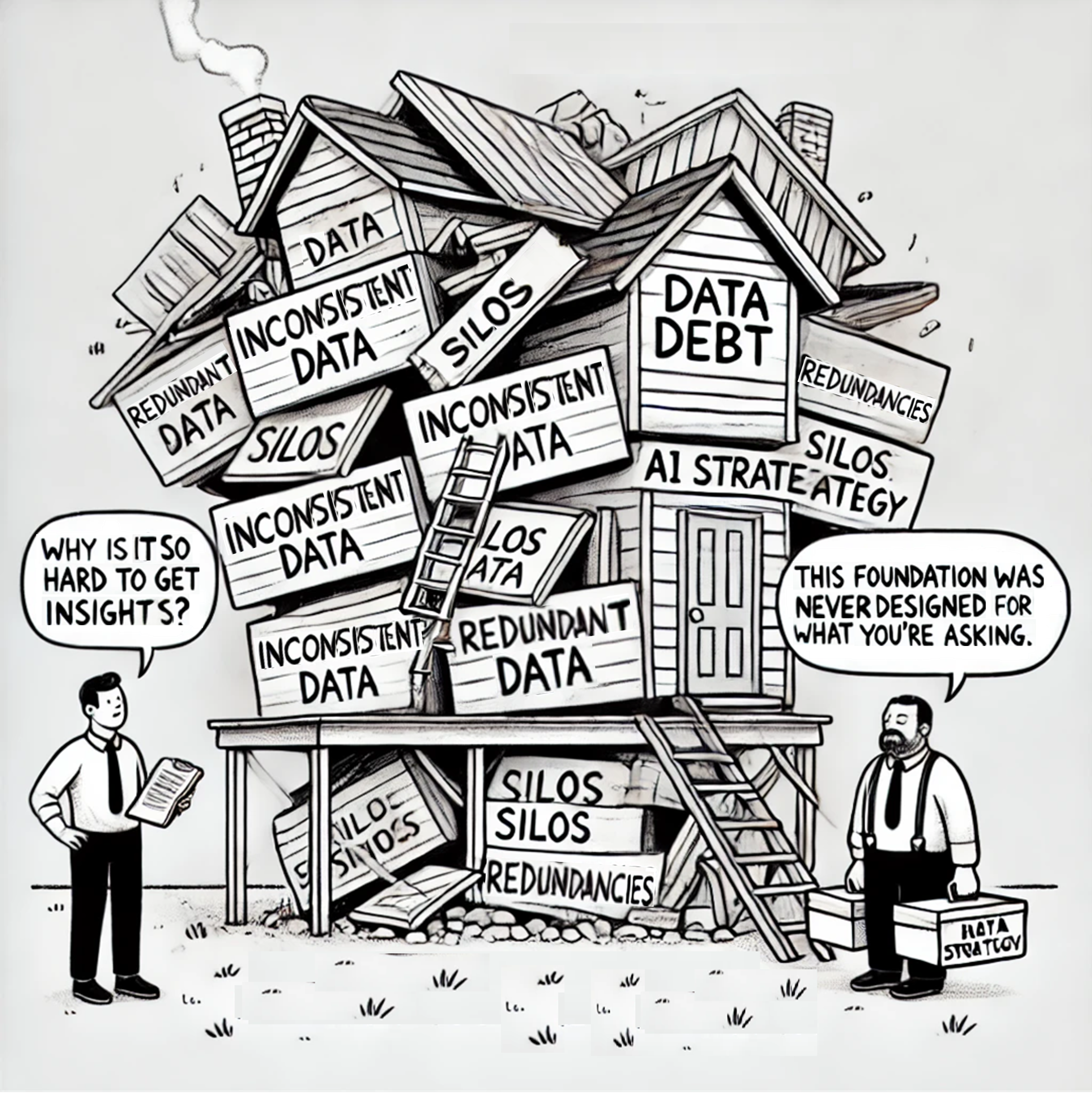
Reckless and unintentional data debt emerged from the combination of cheaper storage costs and a culture of data hoarding, where organizations amassed large volumes of data without establishing proper structures or ensuring shared context and meaning. It was further fueled by resistance to a design-first approach, often dismissed as a potential bottleneck to speed. It may also have sneaked up through fragile multi-hop medallion architectures in data lakes, warehouses, and lakehouses.
Much like coding without design leads to technical debt, this lack of strategic planning resulted in inconsistent, redundant, and siloed data, making integration, analysis, and value extraction increasingly difficult over time.
Shift-left in data management
With data debt, prevention is better than relying on a cure. Shift-left is a practice that involves addressing critical processes earlier in the development lifecycle to identify and resolve issues before they grow into larger problems, and cost a lot more than if originally dealt with. Applied to data management, shift-left emphasizes prioritizing data modeling early if possible -- before data is collected or systems are built.
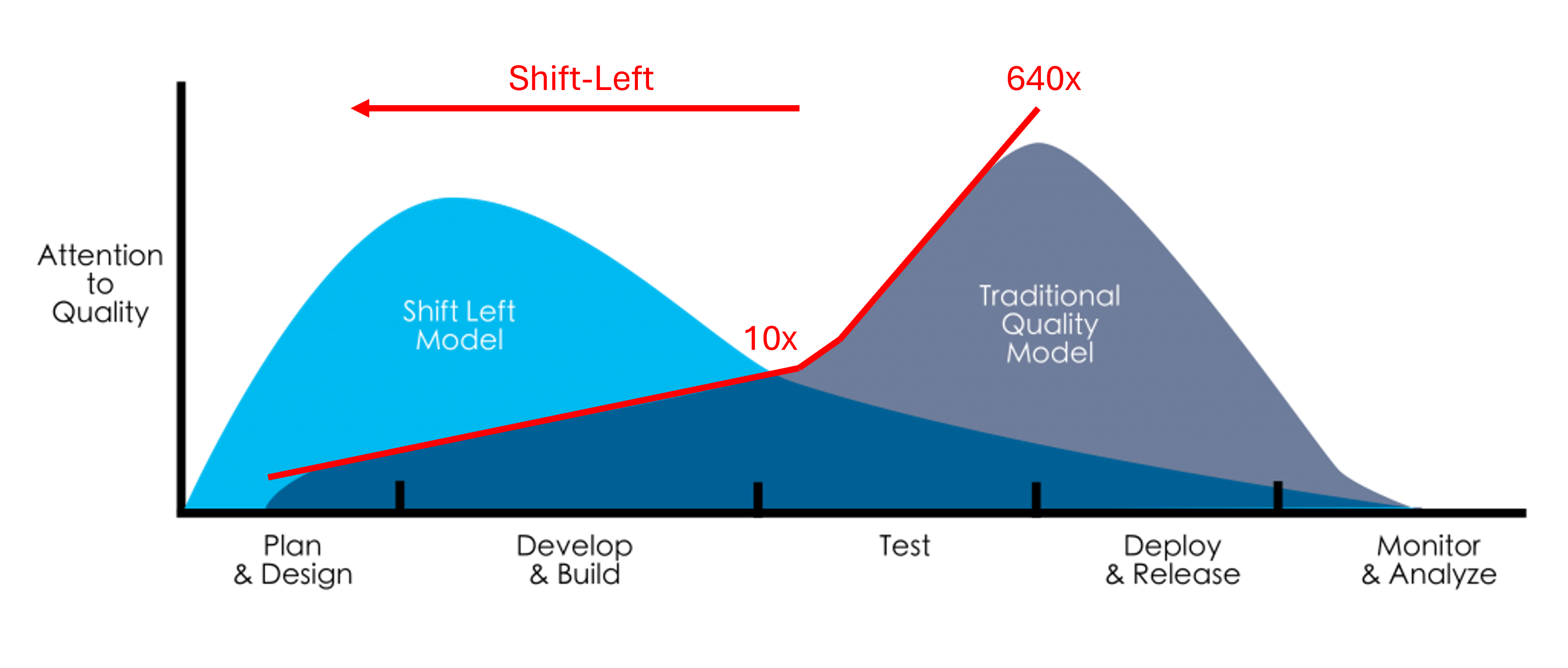
Data modeling allows to follow a design-first approach, where the structure, meaning, and relationships of data are thoughtfully planned and discussed before collection. This approach reduces data debt by ensuring clarity, consistency, and alignment across teams, enabling easier integration, analysis, and long-term value from the data.

By using data modeling at the outset, organizations can define the structure, meaning, and relationships of data in alignment with business needs. This proactive strategy reduces data debt by preventing the creation of inconsistent, redundant, or poorly understood data. It also ensures that both technical teams and business users share a clear understanding of the data, leading to better data quality, easier integration, and long-term scalability. In essence, shift-left empowers teams to "design for the future" rather than fix problems after they occur.
Advocates of a code-first approach should recognize that data modeling is no longer a bottleneck when agile principles are applied alongside domain-driven data modeling.
But every organization most likely already has some level of data debt. What is the plan to get it under control?
Chart your existing data
A data model, like a map or a blueprint, is a visual representation of how data is organized. By examining existing databases, data sources, and data exchanges, organizations can map out entities, attributes, and connections between them into an entity-relationship diagram or a simpler graph diagram.
This process, called reverse-engineering, involves analyzing and charting the structure of existing data to uncover its underlying design and relationships. It helps identify inconsistencies, redundancies, and gaps, enabling better understanding and documentation of the data for improved integration, analysis, and redesign if necessary.
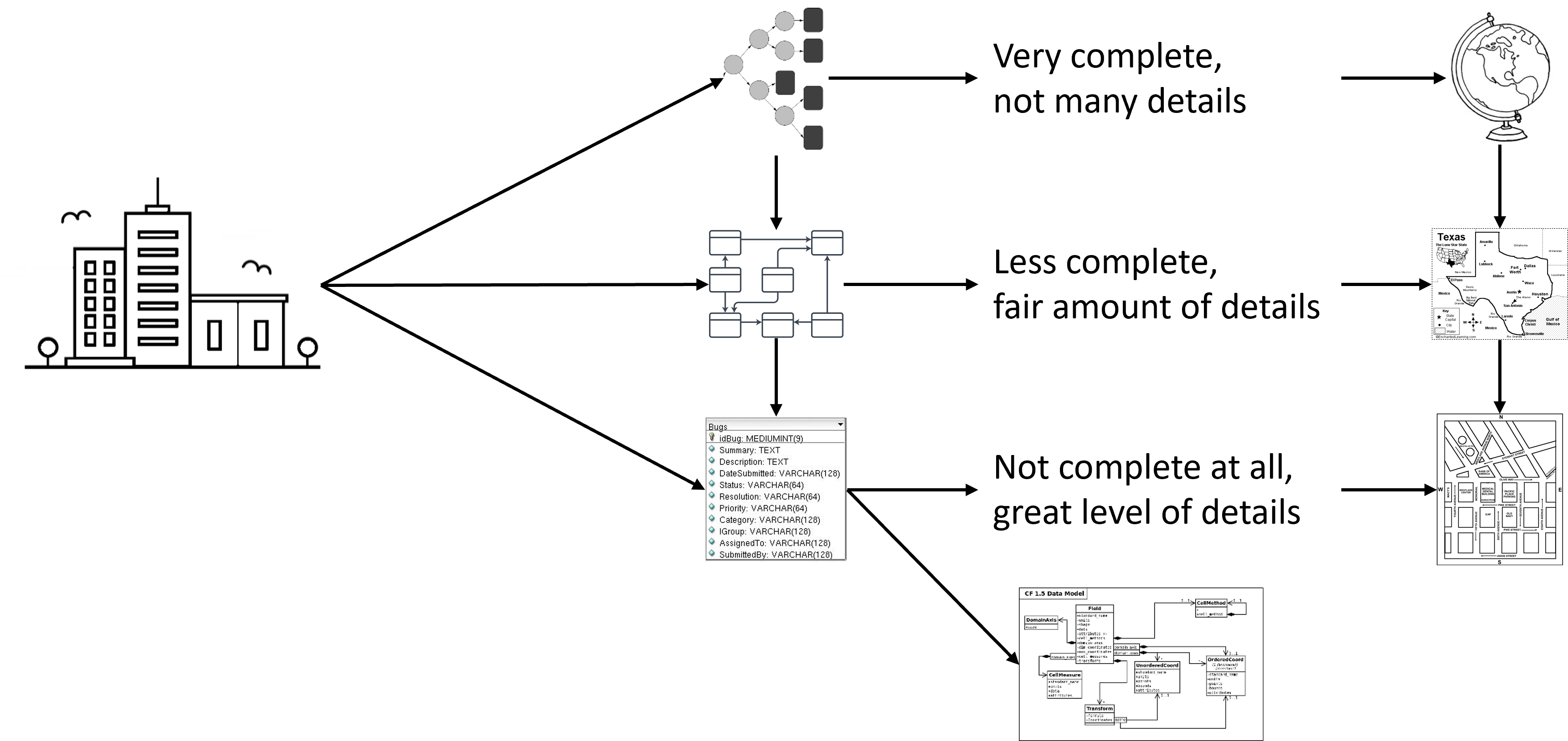
By charting existing data, the process makes definitions, relationships, and structures explicit, bridging gaps between IT and business users. It enables business teams to align on how data reflects operations and processes, while IT departments gain clarity on how the data is used in decision-making, self-service analytics, machine learning, and artificial intelligence. This shared understanding fosters collaboration, reduces misinterpretations, and ensures that everyone -- from technical teams to business stakeholders -- works with consistent and meaningful data.
Metadata management tools and data dictionaries often rely on reverse-engineering and profiling to harvest existing data structures, uncover relationships, and document attributes. While these processes provide valuable insights into the current state of data, they are inherently reactive, focusing on cataloging what already exists rather than designing data structures proactively. This limitation means that they cannot prevent data debt from accumulating, as they lack the ability to enforce proper design principles or align data with business needs from the outset.
Design your future data
Data modeling complements these tools by enabling a design-first approach, where data is thoughtfully structured with shared meaning, context, and future scalability in mind.
A data model is not an end goal. Its purposes include, on the technical side, establishing schema contracts that align with the business requirements of subject-matter experts and are mutually agreed upon by both data producers and consumers. On the business side, it facilitates easy sharing and access to the meaning and context of the data being exchanged and stored.
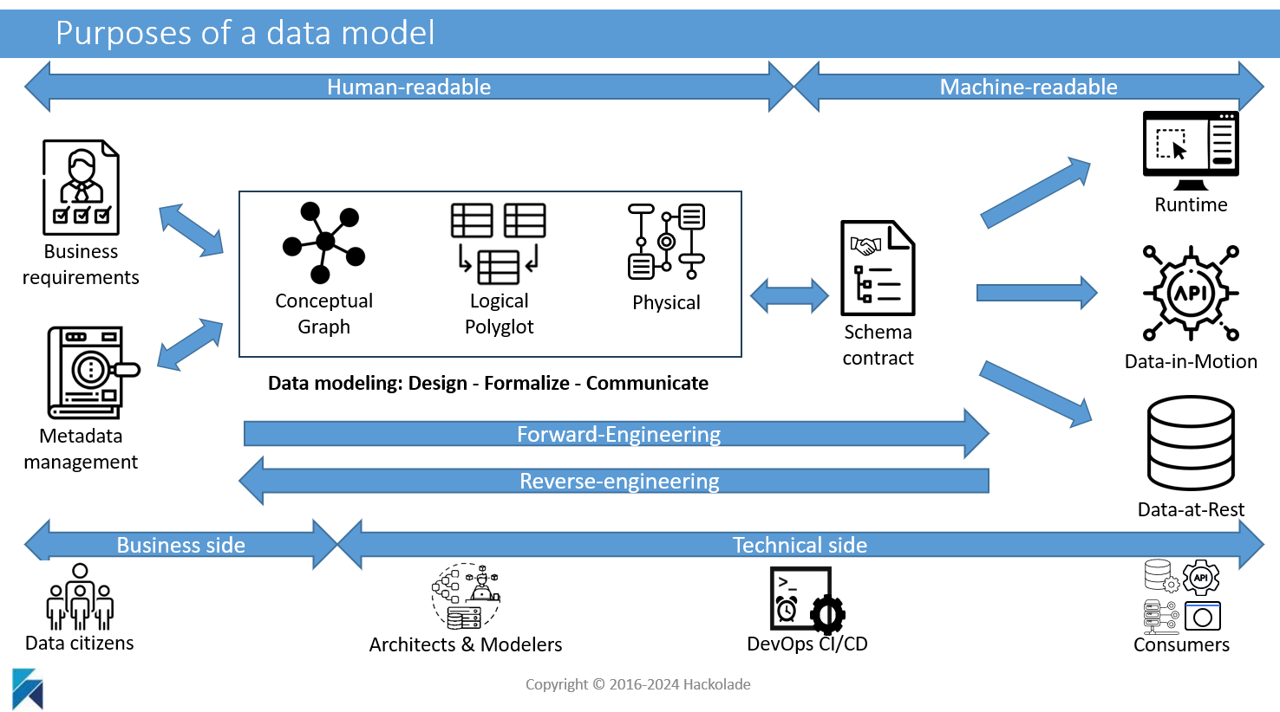
Data modeling not only prevents new data debt by creating a solid foundation but also facilitates the evolution of existing structures. By guiding changes to align with both technical and business requirements, data modeling helps organizations create a more sustainable and efficient future for their data, reducing the burden of past mistakes while ensuring ongoing value.
Data modeling applied also to data exchanges
Data modeling has traditionally been associated with relational databases, whether for transactional or analytical purposes. Over time, this expanded with the rise of NoSQL databases, APIs, event-driven architectures, and microservices.
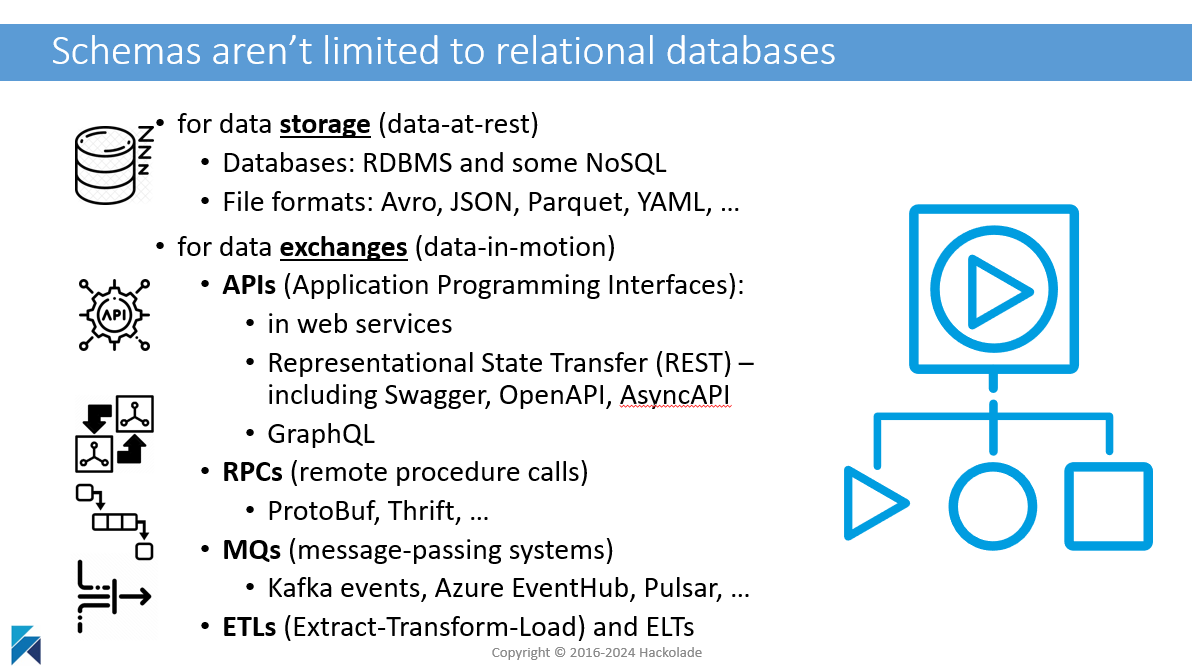
While developers initially focused on the underlying technologies, it has become clear that the key to successful data exchanges lies in the structure of the payload. For effective communication, it is essential for data publishers and consumers to agree on a data contract, with the schema at its core. This schema defines the structure of the exchange, whether it’s an API or a Kafka event.
Conclusion
To reduce your data debt, take the first step by charting your existing data into a clear, comprehensive data model that maps your current data structures. This can be approached iteratively, addressing needs as they arise -- avoid trying to tackle everything at once.
Engage domain experts and data stakeholders in meaningful discussions to align on the context, significance, and usage of the data.
From there, iteratively evolve these models -- both for data-at-rest and data-in-motion -- so they accurately reflect and serve the needs of your organization and customers.
By doing so, you create a strong foundation for data consistency, clarity, and scalability, thereby unlocking the full potential of your data for smarter decision-making and future innovation.